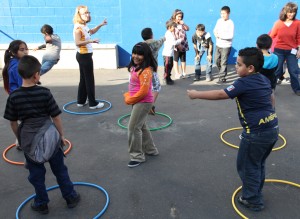Lala Bence, 69, worked as a pre-school teacher for 25 years. “I love children, I retired [from teaching] for a year and I couldn't do without it,” said Bence, who now works with CATCH in San Diego’s Logan Heights neighborhood.
Each class of CATCH Healthy Habits, usually held for one hour each week for up to eight weeks, is made up of three elements -- a healthy snack, a nutrition lesson and physical activity.
The classes always start with adults encouraging kids to eat something healthy such as grains, yogurt, fruit or vegetables. The volunteers then go on to teach nutritional facts. For example, volunteers talk to third and fifth graders about the importance of fiber and to be careful about daily sodium intake. Younger-aged kids, from kindergarten through second grade, learn about food that is healthy versus ones that are unhealthy. Then kids play tag and other games that get them moving.
Erica Macht, coordinator for CATCH, says the curriculum gives children simple tools on how they can make healthy decisions in their lives.
“I always say it's implanting that little seed in their head," says Macht, "They might not get a whole bunch of stuff out of the program, but if they can go away with just a little bit, that would be great."
Proponents say what makes CATCH unique is its intergenerational approach to health and nutrition education. They said the program not only benefits the young, but also the retirees who feel that they are doing something productive.
Bence said the dynamic between the older and younger generations works because the volunteers are seen as the “grandmother and grandfather” figures, unlike other adults, such as a parent or a teacher, who have to play more authoritative roles.
Many of the children said they enjoyed interacting with the seniors.
"They're really nice and caring," said 8-year-old Bubba, a CATCH participant.
Diane Lieberman, 63, said she has plenty of other physical activities, such as cycling and soccer. But she said volunteering is different.
“This is the one thing that I really get the most satisfaction out of,” said Lieberman, who volunteers with CATCH at an elementary school in east San Diego.
“Since I started volunteering," said Malcolm Carmichael, 73, "my general health is so much better than it would be if I didn't participate in these things."
The program is funded by Anthem Blue Cross Foundation and administered around the country through regional branches of OASIS. CATCH is also in Los Angeles County, and program coordinators are looking to bring CATCH to the Sacramento area.
Before and after the 8-week sessions both the children and volunteers take surveys to track whether they changed their eating and exercise habits. Nationally, surveys show a significant increase in physical activity, fruit and vegetable consumption, and nutrition label reading within the adult and children groups.
Volunteers said one important component of the program is that the kids are encouraged to bring what they learn to their families.
“Parents always pay attention to their children no matter what, so if a child says ‘Mom, salt isn't good for you, let's read the label,’ … that's a big deal,” said Bence.
CATCH Healthy Habits is even more important to communities such as Logan Heights, a working-class neighborhood in southeast San Diego.
Ricardo Sandoval the director of Boys & Girls Club, whose membership is 80 percent Latino families, said the kids in CATCH learn about the importance of a balanced lifestyle.
“Especially with Hispanic cooking that might have lard, grease, a lot of carbs … it’s a lot of things that add up,” said Sandoval.
School sites and youth clubs decide who is eligible to participate in the free program. Sandoval said that while CATCH is still new at the Boys & Girls Club, enthusiasm for the program is high.
"I think it's really good and healthy, they always give us healthy foods, and they always make us feel better and they give us healthy stuff," said 8-year-old Heaven.
CATCH Healthy Habits is at 20 locations throughout the San Diego region. This includes elementary schools, youth clubs and some city-run facilities such as local libraries.
Marnette Federis is a freelance writer living in San Diego.
